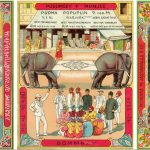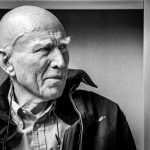Navjot Altaf: An Iconic Journey
Navjot Altaf and a sensibility shaped by Bastar and other distant cultures
 Rosalyn D’Mello
Rosalyn D’Mello
 Rosalyn D’Mello
|
12 Oct, 2016
Rosalyn D’Mello
|
12 Oct, 2016
/wp-content/uploads/2016/10/Anicononicjourney.jpg)
IMPRINTED UPON Navjot Altaf’s body is a secret code: a measured trail of blue-inked dots extending from her right wrist, bordering her back and trailing across to the tip of her left wrist. Isolated from this is a pyramid of dots spread across the width of an inch on her right elbow. She is unsure whether it was the first 12 or 15 dots that she’d had tattooed years ago in Bastar. The rest, she can say for sure, were engraved upon her skin at her studio in Bandra by a Polish artist in memory of Altaf, her lifelong artist partner, and brother of Nasreen Mohamedi. “I’m very shy about my body,” she says, recounting how she’d invited the Polish tattoo artist home so she could securely wrap herself in a towel as she filmed the procedure for Touch 1, 2 & 3 (2008), her prequel to Touch IV. “I was making a point about how, when touch takes place out of choice, it leads to a very intimate situation, but when it is undesired, it is repulsive. Who do we allow to touch our bodies?”
The original trail of 12 or 15 tattooed dots was a way of inscribing the nuances behind two oral narratives she’d been privy to, about the history of the art among Adivasis in Bastar, a region she has been closely associated with since her first trip there in 1996. The first story was told to her by Jaidev Baghel, the Adivasi bell metal sculptor from the Muriya tribe, credited with establishing Shilpi Gram in 1981 in Kondagaon to facilitate greater interdisciplinary dialogue between local artists and their global counterparts. This is how she recounts the exchange:
Jaidev: “When God made man and woman, woman made a mistake.”
Navjot: “As always!”
Jaidev: “Chup! You people always interrupt.”
Navjot: “Hamesha aurat hi galti karti hai (It is always the mistake of the woman)!”
Jaidev: “Yehi hai problem tum sheherwaalon ke saath (That is the problem with you city-slickers). Then God said to the woman, ‘You have to prick yourself for a period of time.’ That’s how the woman got a tattoo.”
Navjot: “How wonderful Jaidevji, for her punishment from God she did not think of destroying her body; instead, she created something beautiful! Mein is aurat ke saath hoon (I am with the woman).”
Kalavati, an Adivasi woman from the Bhatra tribe, told her the second story. “When we’re born, we have nothing on our body. Then we become greedy, we buy gold, silver,” Navjot narrates. “Adivasis in the interiors of Abujmar, where they have good rain and kheti (agriculture), they collect a lot of gold and silver, they wear beautiful jewellery,” she explains, before returning to the first-person tone of Kalavati. “All our life goes in collecting, and when you die, your daughter or son may take off the tiniest bit of jewellery, but [a tattoo] is something that becomes synonymous with the skin.”
Navjot was “very convinced by this story”. However, when the tattoo artist came to Bastar, she got suddenly frightened. “I didn’t know what I wanted to have done. What came to my mind was Duchamp’s urinal [Fountain]… just the dots. So my colleague took a ruler and made the dots.” Navjot eventually projected the footage of the Polish tattooist making a dot-composed pyramid on a urinal. “I called it From R. Mutt to Hindware.”
NAVJOT HAD MET Baghel during a chance encounter back in 1973, when the sculptor was showing his work at Rabindra Bhavan in Delhi. ‘Navjot was barely a year into her practice then and was inspired by the possibility of understanding the struggle of the working class,’ writes Nancy Adjania in her essay ‘Devolution: The Artist-Citizen Redistributes Her Privileges’ in The Thirteenth Position, published in 2016 by The Guild Art Gallery. In the mid-1990s, Baghel visited her studio and for the first time fully fathomed her sculptural practice that was entrenched in Mayan, African and Adivasi iconography. This led to his inviting her to visit Shilpi Gram, where there was still a vibrant wood carving tradition. Navjot, who was by then deeply rooted in the ethos of collaborative, community-based art, having schooled herself in the politics of the art/craft debate—she counts Ernst Fischer’s The Necessity of Art as her most thumbed- through book—naturally accepted.
If I had to leave my house, like most Adivasis, I needed to experience that. This is what happens with displacement
The JJ School of Art alumnus made her first trip in 1996 with art historian Bhanumati Padamsee, thanks to an IFA grant that allowed her to research the memorial pillars installed in public places and to investigate how the female body was represented in Adivasi art. That inaugural trip sowed the seeds for future collaborations. ‘Within a year’s time, a coalition of eight people emerged: Navjot’s assistant Raju Mewada; woodcarvers Rajkumar and Gessuram; bell-metal sculptor Kabiram; Raituram, a master craftsman in stone and wood carving; his wife and assistant Shantabai; the art historian Bhanumati; and Navjot,’ writes Adjania. ‘They began to work side by side at Shilpi Gram, on a project that they titled Modes of Parallel Practice: Ways of World-Making.’
A few years later, as Navjot and her colleagues got more and more immersed in actually building community structures, she was forced to leave Shilpi Gram. “Jaidev said, ‘You people are now no longer artists; you’re masons, you’re digging streets!’” Navjot says, adding that she didn’t necessarily mind the informal eviction. “He was a very strong person, and I felt he did not allow younger colleagues of mine to flourish.” Around that time, the collective had received money from a museum in Japan for a co-produced artwork. Navjot portioned out about Rs 7 lakh from the core amount that was put in a joint bank account to build the Dialogue Center in Kopaweda. “I was almost like a White person there. My colleague found me a chawl-like space with no toilet; we sectioned out a bathroom with plastic,” Navjot says. “The person who I was to hire to clean actually said to my colleague, ‘I wouldn’t live here, you think your Madam is going to live here?’ to which I said, ‘If you have chosen this place, I will stay.’” The stench from the neighbouring nallah was sickening, but this trauma of dislocation proved critical for Navjot. “If I had to leave my house, like most Adivasis, I needed to experience that. This is what happens with displacement,” she says. By 2005, the ‘minimalist campus built around a majestic mahua tree’, as Adjania describes it, was ready, complete with an open studio and workshop spaces meant to promote cross-pollination of ideas. The Dialogue Center gradually evolved into a meeting point. “Then Jaidev became friendly again. I told him that we needed to thank him because he made this happen,” says Navjot. “He said, ‘That’s the lesson, I wanted you to become independent’.”
For years, Bastar has been one of three notional and physical spaces that have collectively constituted Navjot’s studio. The most private, and perhaps the oldest, among these is the three- room space located a few buildings away from where she lives—in an apartment in Pali Hill in Mumbai, which also houses her film editing room. When she is not in Bastar, she floats between either of her two studios. When she is in need of solace from the many disappointments that come with being an artist-activist, she prefers to slip into the quiet of the painting studio and immerse herself in grids and lines. “The comfort is sometimes necessary,” she says. “I just can’t close my eyes otherwise. There’s no action painting done here, just lines. When I come here, I place my chair, open the windows and soak in the breeze.” How Perfect Perfection Can Be, her most recent suite of 24 watercolours that were shown last month at Chemould Prescott Road, was the consequence of this form of meditative solitude. Navjot dwells on the aesthetic of the glass buildings in New York over which she super- inscribes minimal graphic details of statistics pertaining to the irreversible impact of climate change. During my visit, I spot one work from this series that was not exhibited. It is wrapped in butter paper, with differently shaped rulers serving as paperweights. “It’s a reject,” Navjot tells me. “It didn’t have the same luminosity as the others,” she explains, exposing, in part, the crux of the show’s title.
When she escorts me to the next room I quietly gasp. It is a narrow chamber lined by shelves from floor to ceiling; a storehouse of many of her original sculptural moulds and a few rejects. The plaster-of-Paris faces remind me eerily of the Hall of Faces from Game of Thrones. “In college, I threw away work like mad,” she says. “I had so much and no space, and I thought, ‘Let’s throw this, let’s get rid of this.’ We never thought then that one should keep it all as a record of one’s process.”
Fragmented body parts are also on display across four shelves in the adjoining room, sharing space with some of Altaf’s oil-on-canvas pieces. “Just before Altaf passed away, we’d given a lot of his work to [Delhi Art Gallery],” she explains. “After he died, Ashish came and said ‘Since I have [most] of his works, I’d like to take a few more’.” Did she have any qualms about giving them away? “With Nasreen, after we had her first retrospective, for ten years nobody touched her. Then Deepak Talwar came in and bought works and everyone made a noise. Nobody has ever done [Altaf’s] retrospective and now each one is eating our head. It’s so tough when I have all these works, especially the oils. I have to come in from time to time and either clean them myself or stand and supervise while someone else is cleaning. With Nasreen and Altaf, I thought if their work is in somebody’s collection, they’ll take care of it.”
Altaf, who was always a presence within this studio, having shared it with Navjot for years, has been on her mind even more intimately off late. She’s been working on a film on his life for which she has been re-reading his diaries, as well as on a publication in collaboration with DAG in lieu of an upcoming retrospective of his work.
In the centre of the room that used to be Altaf’s studio lies a fibreglass sculpture (a medium she doesn’t honestly enjoy) in a bloody vermillion, of a woman crouched upwards in a foetal position. Navjot carefully unwraps it for me to see the serene facial disposition. “This is a work I did after my father passed away,” she says. “On my birthday, 15 December 1986, and almost exactly when I was born, around 6.30 pm. When I went to see him, he was all wrapped up like a saint. At one point he just said, ‘My time has come’, and he passed away, and I thought that when I was born I must have been lying like this.”

/wp-content/uploads/2025/07/Cover_Dalai-Lama.jpg)













More Columns
From Entertainment to Baiting Scammers, The Journey of Two YouTubers Madhavankutty Pillai
Siddaramaiah Suggests Vaccine Link in Hassan Deaths, Scientists Push Back Open
‘We build from scratch according to our clients’ requirements and that is the true sense of Make-in-India which we are trying to follow’ Moinak Mitra